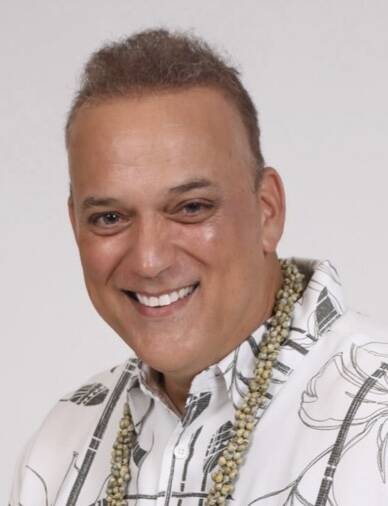Four leading mayoral candidates made their pitches to Big Island residents at a public forum Wednesday.
AARP Hawaii invited Mayor Mitch Roth and three challengers — Kimo Alameda, Breeani Kobayashi and Seaula “Junior” Tupa‘i — to discuss the issues facing Hawaii County. With audience members packed into Aunty Sally’s in Hilo, the four candidates laid forth their visions for how to address the county’s challenges.
The questions below were asked by a moderator during the event.
Question: What is your first priority as mayor, and what will you do in your first 100 days to address it?
Tupa‘i said residents have told him they feel less safe in their communities, and added that the Hawaii Police Department is understaffed, with only one officer per 4,000 residents. Alameda struck a similar note, saying that county workers are overworked and underappreciated, and touted his endorsements by both United Public Workers Hawaii and the Hawaii Government Employees Association.
Roth, meanwhile, said that one of the most difficult initial tasks for an incoming mayor — setting up a cabinet — is already done for his administration. He also said several housing and infrastructure projects, including Hilo wastewater improvements, should be coming to fruition within the first 100 days of inauguration.
Kobayashi said there is a lack of trust in government, and that communities around the island have ideas for how to address their own issues. She said she intends to “hit the ground running” if elected, and that the county can’t afford to wait to learn about issues during the first 100 days; instead, she said, by hearing solutions from residents, her administration will rebuild trust in government.
Q: What steps will you take to streamline the county’s permitting process?
Roth said the University of Hawaii Economic Research Organization rated Hawaii County’s permitting system as the worst in the country when his administration began. Now, he said, it is the best in the state. At the end of 2023, he said the county averaged 27 days to complete a permit; while that rate has slowed since then, Roth said the county is working on getting that number down again.
Alameda countered: “All four counties ended up being pretty much last in the country. So when you go from last in the country to first in the state, you just went from last in the country to fourth-last in the country.” He added that his administration would be more forthcoming with data, so that residents are aware of how many people are in the permit queue.
Kobayashi and Tupa‘i both touted the need for better dialogue. Kobayashi said there should be dialogue between architects, engineers, contractors and the county to learn what problems each group is facing, while Tupa‘i said county agencies need to work more closely together to prevent kinks and snarls in the county’s EPIC permitting system.
Q: State Act 39, passed this year, requires the counties to pass laws allowing at least two accessory dwelling units on residentially zoned lots, with certain conditions. How do you expect to see that implemented?
Alameda, Kobayashi and Tupa‘i all agreed that deregulating housing is vital to keeping the island affordable and praised Act 39 for opening up additional dwelling units. Tupa‘i added that ADUs can give residents an additional income stream, but recommended putting a cap on allowing nonresidents to rent out ADUs.
Meanwhile, Roth touted the number of affordable housing units in the county’s pipeline: more than 8,100 units currently, up from 1,243 at the start of his administration.
“We have made tremendous progress, and I don’t think any of these guys will deny it,” Roth said, gesturing toward his fellow candidates.
Q: What will you do to provide more resources to caregivers and allow kupuna to live independently?
Kobayashi said the nonprofit Hawaii Rise Foundation — of which she is executive director — offers a program that educates elderly residents about how to engage with technology and the internet without being exploited. Those resources, she said, should be expanded into rural communities and available for free.
The county should advocate for in-home care workers to be exempt from the state general excise tax, Tupa‘i said, and should increase wages for care workers.
Roth praised the county’s Office of Aging and its programs such as Meals on Wheels. He said the county is advocating for a pay hike for in-home care workers, something Alameda echoed as well.
“If the county can alleviate (caregivers’) burden, by providing services, by providing training … maybe even an increase in the stipend, that would be awesome,” Alameda said.
Q: What resources will your administration provide to help the homeless and relocate them away from downtown Hilo?
Tupa‘i challenged attendees to say whether they have seen any improvement in Hilo’s homeless situation despite the county spending more than $20 million on the issue in the last two years. When nobody raised their hand, he went on to call for an audit of the county’s homelessness spending to determine what that money is going toward.
On the other hand, Roth said the last homeless Point In Time count saw a 28% decrease in homelessness, but acknowledged that, at the ground level, that decrease can be hard to perceive. He brought up the recent temporary camp set up on Ponahawai Street and said more permanent shelter locations are in the works at the Old Memorial Hospital and in Kailua-Kona.
As a counterpoint, Kobayashi said that while the last Point In Time count did see homelessness drop by 28%, the prior count was the highest it had ever been. She added that 70% of homeless individuals suffer from mental health or substance abuse issues, and that investing in resources to treat those issues is necessary to reduce homelessness, along with repurposing vacant buildings.
Alameda said the county should also dedicate resources to the almost-homeless: kupuna one paycheck away from losing their homes, foster children aging out of the system, released inmates with no safety net.
Q: What policies would you support to help small farmers?
Roth said that farmers are finding it too expensive to ship produce between islands. To address that, he said he is investigating the possibility of a state subsidy to help farm shipments.
Alameda said the county could reduce property taxes for farmers or consider using its Public Access, Open Space and Natural Resources fund to support agriculture.
Kobayashi said she would seek partnerships with community land trust associations allowing new farmers to grow produce on their properties. At the same time, she said she supports efforts to support ecotourism, and touted the regenerative tourism promoted by the SCP Hilo Hotel, of which she is the general manager.
Tupa‘i advocated for more slaughter sites for ranchers, more USDA inspectors so that meat can be sold, more community gardens, and greater local food sustainability given the unstable political situations around the world.
Q: What policies will you support to help protect kupuna in the event of a disaster?
Alameda said the county’s data systems need to be robust so that, if an emergency strikes, responders can quickly determine where vulnerable people are and what their needs will be — but, he added, additional staffing would be necessary to support that data.
“I believe that if you give people the tools and resources, they’re that much better off,” Kobayashi said. She advocated for expanding the county’s Community Emergency Response Teams, so that residents can reliably go to a local community group for information during an emergency. She added the county’s General Plan needs to be updated as soon as possible.
Tupa‘i agreed that more CERT teams are needed in each community, and that Hilo’s general plan hasn’t been updated since 1975 — seemingly in reference to the Hilo Community Development Plan.
Roth appreciated the nods toward the CERT program, noting that he helped establish that program 20 years ago.
Q: What is your position on the Thirty-Meter Telescope?
Kobayashi and Tupa‘i were skeptical of the telescope. Tupa‘i said the environmental impacts of the observatory could compromise the county’s goals of being self-sufficient, and that the people from whom the government derives its power have been vocal in their opposition to the project.
“If there is something that people are literally willing to kill themselves over, is anything of that worth it?” Kobayashi said, adding that the county’s role in the issue should be to be seeking a resolution to the conflict.
Alameda took a more conciliatory tone, saying that while he opposed the project in 2019, “the 2024 version might be better” now that management of Maunakea is on track to shift from the University of Hawaii to a new state agency. He added that his role in addressing the matter will be to find consensus between both sides of the debate.
Roth said that, ultimately, he supports TMT, saying that astronomy provides jobs that allow Big Islanders to continue to work on the island without having to move away.
Quick question: Can the county build all the necessary affordable housing, while maintaining environmental and infrastructure quality over the next four years without raising fees or taxes?
With only 30 seconds to answer, Alameda, Kobayashi and Tupa‘i all said yes: Alameda said it would be possible if the Department of Hawaiian Home Lands successfully clears its backlog, Kobayashi said the county could aggressively pursue state and federal grants, and Tupa‘i said “where there’s a will there’s a way.”
Roth was less relentlessly optimistic: “The answer is clearly ‘no,’ we’re talking about billions upon billions of billions of dollars.”
Quick question: Should the Panaewa Zoo charge admissions?
Roth and Tupa‘i supported a nominal fee to support the zoo’s animals. Kobayashi said she would prefer to keep as many activities for families as possible are kept free.
Alameda said that, if the zoo begins charging money, it should at least have more exotic animals.
Email Michael Brestovansky at mbrestovansky@hawaiitribune-herald.com.















